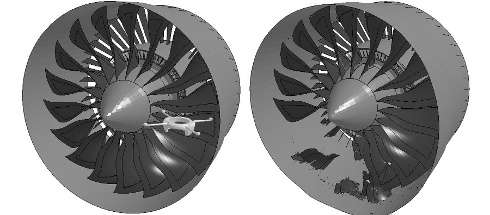Engineering researchers seek remedies for threat posed by drones to commercial airliners

Virginia Tech researchers are urging changes in how commercial aircraft engines are designed in the wake of a possible new threat to passenger aircraft safety: the likelihood of drones, or unmanned aerial vehicles, being sucked into turbofan engines at high speeds.
Such an impact – be it unintentional or part of a malicious act—would be devastating to the engine as its blades are ripped to shreds after "ingesting" the hard-shell center of a drone's electronics housing.
Computer-simulated tests completed by researchers at Virginia Tech's College of Engineering are eye-raising: An 8-pound quadcopter drone can rip apart the fan blades of a 9-foot diameter turbofan engine during take-off in less than 1/200th of a second. The speed of drone debris thrashing about inside the engine could reach speeds 715 miles per hour. Broken blades also would create more fragments as the fan crumbles and warps the engine block housing, contributing to catastrophic engine failure.
"Because the damage is spread to a large section of the engine, it is unlikely that it will be able to maintain thrust," said Javid Bayandor, an associate professor of mechanical engineering at Virginia Tech and director of the university's Crashworthiness for Aerospace Structures and Hybrids – or CRASH, for short – Laboratory.
Bayandor is spearheading the in-progress study of drone-engine impact with fellow faculty member Walter O'Brien, the J. Bernard Jones professor of mechanical engineering at Virginia Tech. Also on the project are mechanical engineering doctoral students Kevin Schroeder of Tulsa, Oklahoma, and Yangkun Song of Seoul, South Korea. Schroeder and Song are members of the CRASH Lab.
Work originated three years ago with the group computer modeling advanced turbofan aircraft engine impacts by birds. The group's efforts switched to drones as news accounts surfaced of pilots spotting unmanned craft in commercial airspace. Further, news media in California have reported instances where firefighters using aircraft to battle forest fires were unable to fly due to flight path interference by drones.
"Because of the unprecedented damage a small or even micro unmanned aircraft systems can inflict on a passenger aircraft, pilots cannot risk flying in the same airspace where there are drones," said Bayandor. "While strict regulations are already in place to isolate drones from operations in controlled airspace, their enforcement have proven challenging, due to the anonymity of drone users."
U.S. Federal Aviation Regulations require commercial aircraft to adhere to design criteria that help ensure the aircraft's survival after a midair collision with smaller "soft" airborne objects, i.e. birds. However, little investigation has been conducted on the ingestion of drones into larger engines.
"As of yet, there are no specific certification requirements to account for procedures to be executed by pilots to remedy such a situation," said O'Brien. "Drones create a new dimension in aircraft foreign object impact challenges that we need to address."
Both men urge that more education on safe drone flight use is vital. Bayandor and his team already are exploring various methods that could be used to prevent more critical collisions of drones and aircraft. The team notes that engine failure rates and timing can change with different commercial aircraft and different relative impact velocity between the drone and the plane.
Use of drones worldwide continues to increase. Commercial unmanned aerial vehicles in U.S. skies alone could add more than $13.6 billion to the national economy by the 2019 and $82.1 billion by 2025, according to the Association for Unmanned Vehicle Systems International.
Provided by Virginia Tech



















